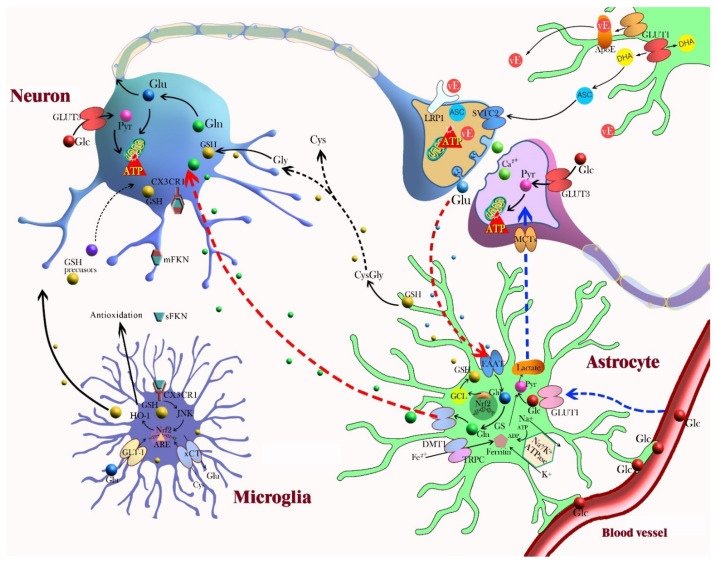Figure 3.
This diagram represents neuron–glia crosstalk involved in neuroprotection and the antioxidant defense mechanism. Astrocyte-neuron: Astrocytes contain a variety of antioxidant molecules, including glutathione (GSH), ascorbate, and vitamin E (vE), and ROS-detoxifying enzymes, such as GSH S-transferase, GSH peroxidase, thioredoxin reductase, and catalase. Astrocytes project the end-feet processes onto brain capillary surface so that astrocytes control the movement of molecules and cells between the vascular compartments and the brain. In the lactate shuttle, astrocytes support neurons by regulating glucose transformation into lactate, which ensures the energetic support of neurons. Neuronal activity triggers glucose metabolism in astrocytes. Glucose is converted to pyruvate by glycolysis and to lactate, which is released from astrocytes and taken up by neurons (blue arrow). Astrocytes can synthesize GSH via activation of Nrf2 and can shuttle GSH precursors to neurons for GSH synthesis. Astrocytes release GSH into the extracellular space and neurons take up the GSH directly or use extracellular neuronal aminopeptidase N to form glycine and cysteine (black arrow). In glutamate uptake and recycling, glutamate from the synaptic space enters astrocytes through EAAT and is converted by glutamine synthetase (GS) to inactive glutamine. After its release and import into neurons, glutamine can be re-converted to glutamate (red arrow). Recycled ascorbate can directly scavenge ROS and act as a cofactor for the recycling of oxidized vE and GSH. Astrocytes take up dehydroascorbic acid (DHA), an oxidation product of ascorbate, from the extracellular space and recycle it back to ascorbic acid. Astrocytes capture and transport excess extracellular K+ to the astrocytic syncytium through Na+/K+ ATPase. Nrf2 induction of glutamate cysteine ligase (GCL) increases GSH synthesis in astrocytes, and GSH is subsequently exported to the extracellular medium. Astrocytes also participate in metal sequestration in the brain to prevent the generation of free radicals by redox active metals. Microglia-neuron: Microglia contain a high cellular GSH concentration and express and upregulate diverse antioxidant enzymes. The expression of classical antioxidant proteins are controlled by Nrf2 in microglia. Heme oxygenase-1 (HO-1), an antioxidant enzyme upregulated by Nrf2, inhibits NOX2 activation. Fractalkine (FKN) is predominantly expressed on neuronal cells, and microglia and neurons exclusively express the fractalkine receptor (CX3CR1); this is an interesting signaling axis for communication. Abbreviations: ARE, antioxidant response element; ASC, ascorbate; ApoE, apolipoprotein E; xCT, cysteine-glutamate exchanger; Cys, cysteine; DHA, dehydroascorbic acid; DMT1, divalent metal transporter; EAAT, excitatory amino acid transporter; mFKN, membrane-anchored fractalkine; sFKN, soluble fractalkine; CX3CR1, fractalkine receptor; Glc, glucose; GLUT, glucose transporter; Glu, glutamate; Gln, glutamine; GSH, glutathione; GCL, glutamate-cysteine ligase; GS, glutamine synthetase; GLAST, glutamate aspartate transporter; GLT1, glutamate transporter 1; Gly, glycine; HO-1, heme oxygenase-1; JNK, c-Jun amino terminal kinase; LRP, lipoprotein receptor-related protein; MCT, monocarboxylate transporter; Nrf2, nuclear erythroid-related factor 2; Pyr, pyruvate; SVTC-2, sodium-dependent transporter; TRPC, transient receptor potential canonical.

